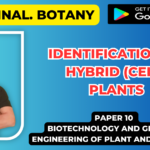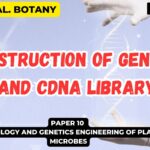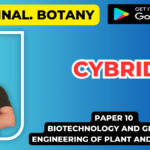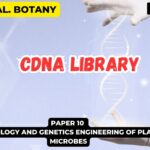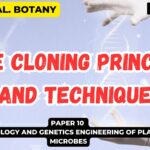![]()
Selection of Somatic Hybrids
- After fusion treatment the protoplast population consist of a heterogenous mixture of unfused parental types, homokaryons, and heterokaryons.about 20-25% of the protoplast are actually yield in the fusion.
- It is necessary to identify or select the suitable hybrid cell for further culturing.
- Various selection procedures are employed.

1. Biochemical method :
- (Carlson et. all 1972) demonstrated the value of a biochemical based selection procedure of somatic hybridisation of Nicotiana species.
- This selection procedure was based upon a prior knowledge of the nutritional requirements of mesophyll protoplasts isolated from the genetically tumorous N glauca and N langsdorti.
- The biochemical method for selection of hybrid cells are based on the use of biochemical compound in the medium.
- These compounds Help to sort out the hybrid and potential cells based on their difference in the expansion of characters.
- Protoplasts of the hybrid were able to grow in culture to form callus, whereas parental types failed to develop into a callus.
1) Drug sensitivity.
- Power et al ( 1976) utilised the differential sensitivity of protoplasts isolated from Petunia parodi and P. hybrida to the drug actinomycin D.
- In an MS medium the mesophyll protoplasts of P. hybrida develop up to a macroscopic callus stage and those of P. parodii divide to form only small cell colonies.
- The addition of actinomycin D to the culture medium apparently has little effect on the regeneration potential of P.parodi protoplasts but those of P. hybrida fail to divide Heterokaryons, are able to grow despite the presence of the drug and ultimately differentiate into somatic hybrid plants.

2) Auxotrophic mutants :
- Auxotrophic are mutant that cannot grow on a minimal medium and therefore require specific compounds to be added to the medium.
- The selection of somatic hybrids as a result of complementation by auxotrophic mutants may be useful as only the hybrid lines are expected to survive In the minimal medium, Although isolation of such mutants of higher plants is difficult.
- Nitrate reductase deficient (nitrate non utilising) mutant of tobacco (N.tobaccum) are known. The parental protoplast of such species cannot grow with nitrate as the sole source of Nitrogen while the hybrid can grow.
- Two species of Nitrate reductase deficiency one due to lack of apoenzyme ( nia type mutant ) and other due to lack of molybdenum cofactor (oxo -type mutant ) are known. The Parental protoplast can not grow on nitrate medium while the hybrid can grow.
- Protoplasts of two genetically different mutants were fused and cultured in a medium containing nitrate as the sole nitrogen source.
- In control experiments, parental protoplasts did not grow in the presence of nitrate whereas fusion products regenerated.
- The selection of auxotrophic mutant is possible only if the hybrid cell can grow on a minimal medium. another limitation of the technique is the the paucity of higher plant auxotrophs.

Visual Method
- In most of the somatic, hybridisation experiments. selection procedures involves fusion of chlorophyll deficient (non-green) protoplasts of one parent with the green protoplasts of the other parent sincc this facilitates visible identification of heterokaryons all the light microscope levels .
- Non green protoplasts are isolated from cultured cells, epidermal cells. or antibiotic induced albino plantlets.
- The heterokaryons are bigger and green in colour while the parental protoplasts are either small or colour less.
- Identification of these heterokaryons has to be carried out to when developing the specific hybrid plant.
- There are two approaches of this direction growth on selection medium and mechanical isolation.
Visual selection coupled with differential media growth:
- There exist certain natural differences in the sensitivity of protoplast to the nutrient of a given medium’.
- Thus some media can selectively support the development of hybrid but not the parental protoplast.
- In this method if species A is wild type and green and another species b Albino or non-green are fused together. the fusion carried out properly it gives rise to green cell colonies that form green callus.
- if the fusion not occur it may give white callus or no growth occur in the media.

Mechanical isolation
The visually identify heterokaryon under the microscope can be isolated by mechanical means. involve the use of special pipette name Drummond pipette.
the isolated heterokaryon can be cloned to finally produce somatic hybrid plant
The major limitation of this method is that each type of hybrid cell required a special culture medium for its growth. can be overcome by employing microdrop culture of single cell using feeder layers.

